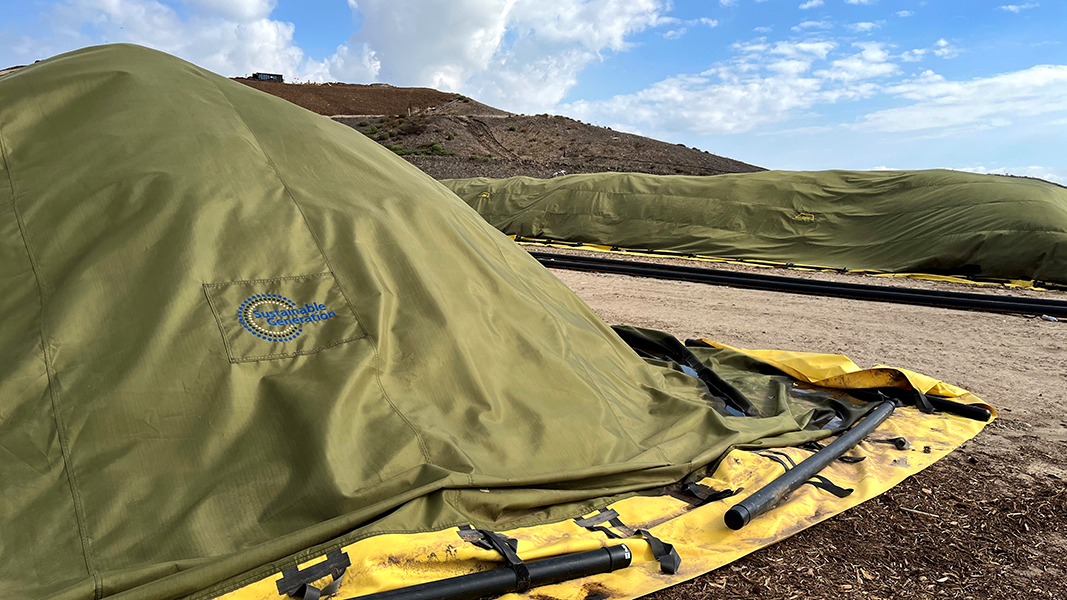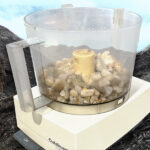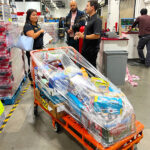Top: Republic Services is using Sustainable Generation’s SG Mobile® System with GORE® Covers at its Otay Landfill composting facility.
Nora Goldstein
Running electricity to an active landfill is a challenging proposition due to the continuous activity of excavating and filling cells with incoming municipal solid waste. At the same time, landfills can be ideal sites for composting facilities given their existing zoning, permits, and truck traffic flow. Faced with an ideal composting site but a lack of power, one solution is solar power and battery storage — which is exactly what Republic Services (Republic) implemented at its Otay Landfill in Chula Vista, California.
“It is very difficult to run electric onto an active landfill,” explains Chris Seney, Republic’s director of Organics Operations. “We wanted to utilize aerated static piles (ASP) to compost green waste and food waste, but needed the ability to access the landfill when needed in the future. This facility can be located anywhere on the landfill. It’s just a matter of moving the solar system, which gives us a lot of flexibility into the future, especially as Otay is an active landfill.”
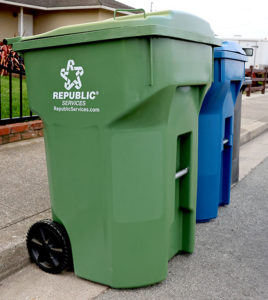
Starting on January 11, households in Chula Vista will be required to source separate their food waste and add it to their green waste cart for collection.
Republic is the franchise hauler for the City of Chula Vista (pop. 281,000), which is located in San Diego County. California’s SB 1383 law requires jurisdictions in the state to have programs in place to divert organic wastes from disposal by January 2022. Republic services 78,000 households in Chula Vista, and most have 64-gallon carts for green waste that is collected weekly. Starting on January 11, households will be required to source separate their food waste and add it to their green waste cart for collection. All food waste and food-soiled uncoated paper will be collected. Residential green waste and food waste from the City of Carlsbad (CA) will start coming to the Otay site in July 2022.
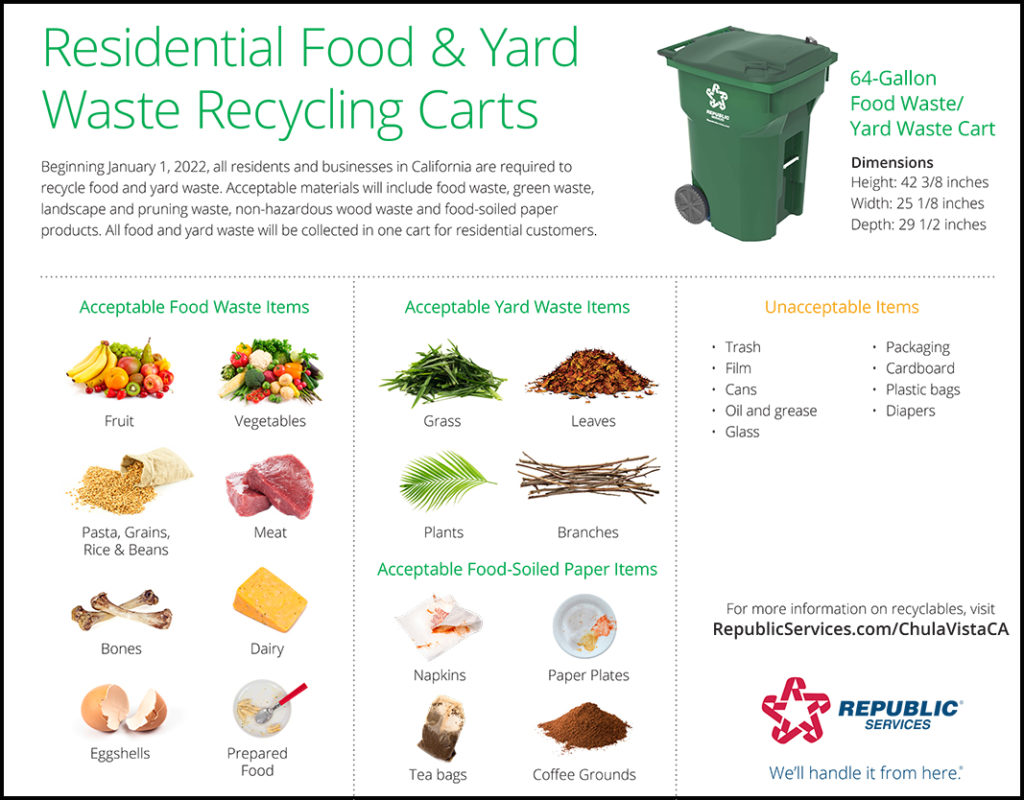 “We’ve been doing outreach and education about the requirement to source separate food waste to Chula Vista households for almost two years,” notes Manuel Medrano, Chula Vista’s Environmental Services Manager. “Our efforts are often touted by CalRecycle and partner jurisdictions and moving forward we will continue to create awareness with a far-reaching multi-media bilingual campaign that will involve television, radio and web. Republic is purchasing kitchen caddies that it and the city will distribute at public libraries, city hall, special events, workshops and other venues.”
“We’ve been doing outreach and education about the requirement to source separate food waste to Chula Vista households for almost two years,” notes Manuel Medrano, Chula Vista’s Environmental Services Manager. “Our efforts are often touted by CalRecycle and partner jurisdictions and moving forward we will continue to create awareness with a far-reaching multi-media bilingual campaign that will involve television, radio and web. Republic is purchasing kitchen caddies that it and the city will distribute at public libraries, city hall, special events, workshops and other venues.”
He adds that rate increase notices are being mailed to households the week of November 15, and that a public hearing about the increase will be held in January. “Rates are increasing by $3-$4/month/household,” says Medrano. “The state regulation requires us to notify households about the increase.”
Several nonprofit organizations offer curbside food waste collection, but only accept vegetative material. Because of the city’s franchise agreement with Republic, households cannot be charged for the collection service — thus it is a called a bucket exchange. “Because these services do not accept meat, dairy and soiled paper, households participating in the bucket exchange will still need to divert those materials via Republic’s curbside collection,” adds Medrano.
Going Solar
The new 6-acre Otay composting facility is permitted to process 200 tons/day (tpd) of green waste and residential and commercial food waste. Republic selected the SG Mobile® System with GORE® Covers powered by the SG Solar™ Power Solution, supplied and installed by Sustainable Generation. SCS Engineers provided design support and engineering services for the project.
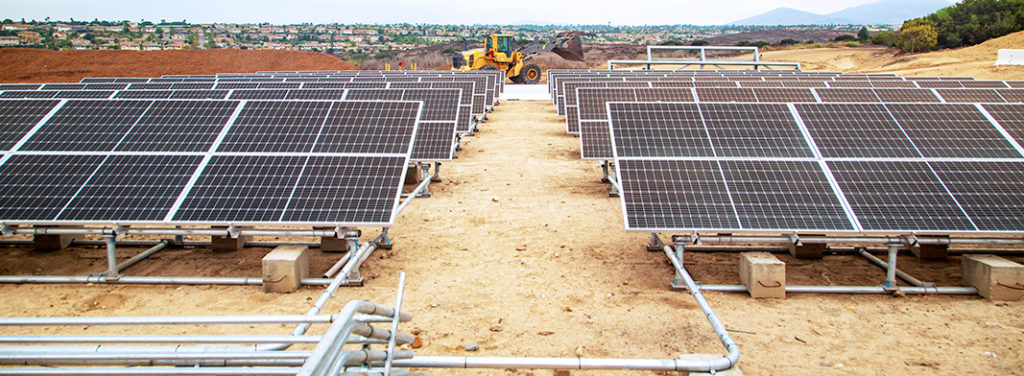
There are 168 solar panels arranged in 14 solar arrays that generate 43 kW of electricity, and 573 kW of battery storage.
The facility opened in September 2021 with capacity to process 100 tpd; construction is underway to install the equipment needed to process another 100 tpd. There are 168 solar panels arranged in 14 solar arrays that generate 43 kW of electricity, and 573 kW of battery storage, enough to power the site for three days in case of inclement weather. The system, which also supplies electricity to an office trailer and runs the air conditioning, is sized for when the facility is composting 200 tpd of material.
Sustainable Generation worked with Republic on a pilot-scale facility at the Otay Landfill, which ran from 2018-2020. The pilot incorporated the solar panels and battery storage. “We wanted to get comfortable with operating an off-the-grid system and experiment with the amount of food waste that could be mixed with the green waste in the GORE system,” notes Seney. “Our permit allows us to receive up to 10% food waste with the ground green waste.”
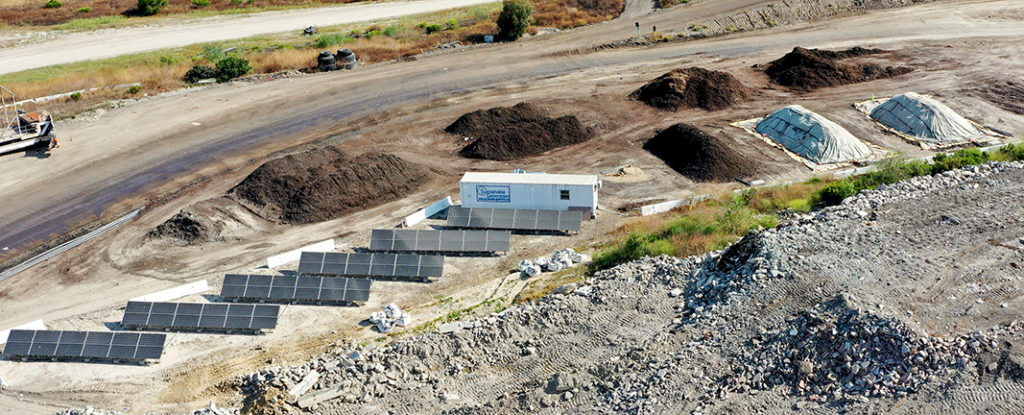
Sustainable Generation worked with Republic on a pilot-scale facility at the Otay Landfill, which ran from 2018-2020. The pilot incorporated solar panels and battery storage. Photos courtesy of Republic Services
Scott Woods, founder and CEO of Sustainable Generation, said the company had been getting requests from companies and communities about the possibility of utilizing solar power to run its SG GORE composting system. “They explained that they have great locations for a facility, but the locations don’t have any power,” he says. “I felt confident that we could run our systems on solar power, so we designed a demonstration unit and ran a demo at the US Composting Council Conference in 2018 to prove it could work. Then we installed a solar-powered compost solution at the Earth Matter food scraps composting site on Governors Island in New York City, which also operated well. So when Republic reached out in 2018, we collaborated with them on a demo at the Otay Landfill. The site is about a mile away from a power source. We saw this as a great opportunity for our company to provide the proven solution for their needs.”
He adds that the SG Solar Power Solution is only for Sustainable Generation’s systems. “It’s an enabling technology,” he says. “Power needed to process one ton of material through the GORE system is less than two kilowatt hours. This runs the blowers and the compost control system including temperature and oxygen sensors. The 8-week, 3-phase composting process — two active phases under GORE Covers and one open air curing — is all under aeration. Our system has lower electrical consumption due to our control of oxygen. The blowers run only when the microbes need oxygen, which is determined by the oxygen content measured by the sensor.”
The 6-acre site is graded and includes storm water controls. Moisture needed for the composting process is supplied by reclaimed wastewater from the Otay Water District. Incoming organic materials are size-reduced in a horizontal grinder to a particle size of about 3 to 4 inches. After the 8-week composting process, Republic screens the material into one-quarter and three-eighth inch fractions. A mulch fraction also is produced. Republic will be marketing the soil products to local jurisdictions, farms and landscapers, as well as other buyers.
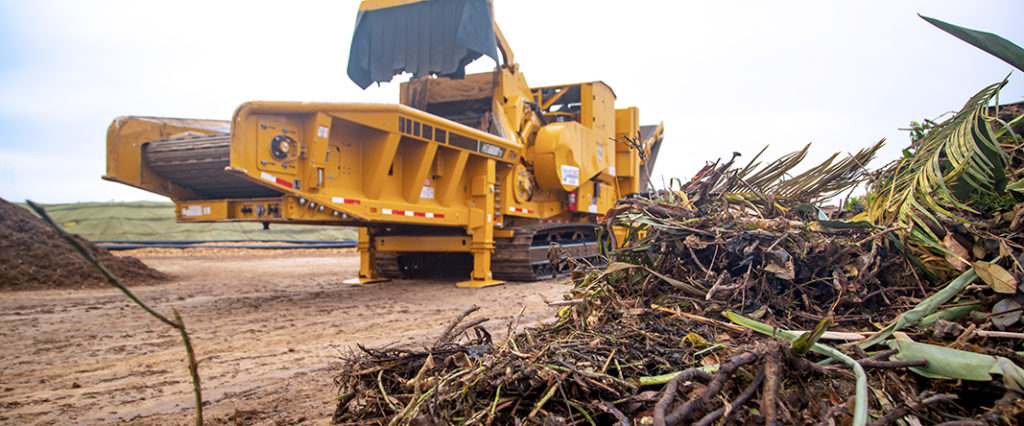
Incoming organic materials are size-reduced in a horizontal grinder to a particle size of about 3 to 4 inches.
SB 1383 requires cities and counties to procure annually a quantity of recovered organic waste products, including compost and mulch. The amount that must be purchased is based on the population; the materials must be used within the boundaries of the city or county.
“Chula Vista will be required to purchase upwards of 22,000 tons of mulch or about 13,000 tons of compost under this provision,” explains Medrano. “We are in the process of determining if there is enough acreage within the city’s boundaries to responsibly apply the material. Under our contract with Republic, it will give compost or mulch to the city, but we will incur the labor costs to apply the material. Discussions are underway with property management groups in the jurisdiction to assess their needs. And a group of landscape architects and representatives of the Chula Vista Parks Division are going to the Otay composting facility this week to test utilization of mulch and compost application equipment, including blower trucks, with the compost and mulch being produced. The City of Chula Vista believes in a circular model approach to the production and use of the material, but it has to be done responsibly and in a way that will not affect current viable markets.”


